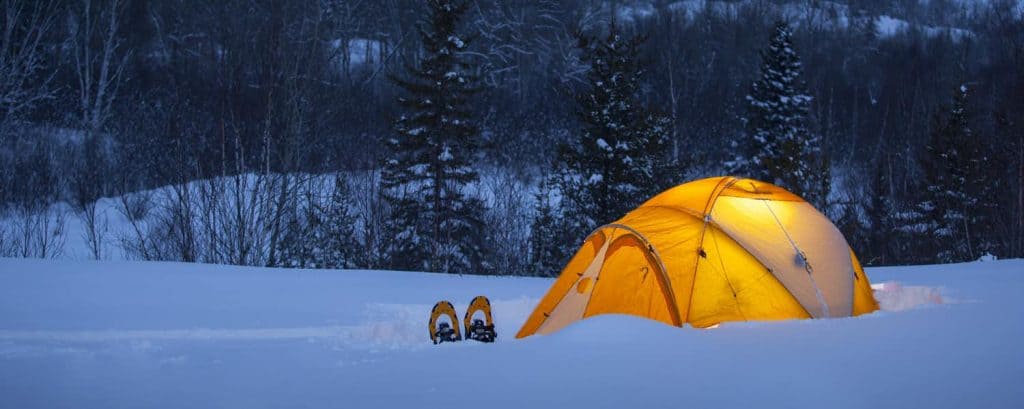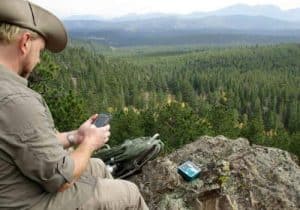How to Survive Winter in a Tent
- Last Updated : October 19, 2022
Before you attempt to embark on an expedition in the frigid temperatures, make sure you fully understand how to survive winter in a tent.
It is possible to safely spend the winter in the great outdoors living in a tent, but it takes a lot of planning, preparation, and know-how.

One of the most dangerous perils that winter survivalists face is hypothermia. Staying warm is your mission, and everything else is secondary. The purpose of this article is to help guide you to a safe, healthy, and enjoyable winter in the wilderness. Tent living is challenging and difficult, but not impossible, as outlined in more detail below.
While planning and preparation take some time and effort, it can mean the difference between having a successful, tent-living winter and a dangerous one that has to be abandoned due to physical safety concerns. So, get your pen and paper, because there are a lot of supplies to gather and many rules of thumb to remember, but it’s ultimately worth it for an unforgettable winter spent living off of the beaten path.
A Basic Checklist
First, remember that safe winter survival depends on preparation. Please note that it is highly recommended that you always travel with a buddy. Going on any sort of winter trek alone, whether cross-country skiing, mountain climbing, or otherwise, is extremely dangerous. While there is a certain appeal to going on a solitary mission, solo camping is exponentially more dangerous. It is simply too hazardous to spend the winter outside without a partner. So, once you’ve selected a trustworthy, experienced and reliable partner, you can continue planning.
The next step involves making a detailed supply list. Ensure that you have the following basic items before heading into the woods:
- A First-aid kit
- Warm, insulated sleeping bag (look for one that is temperature rated)
- Foam sleeping pad, closed-cell
- Coupler strap
- Sturdy, water-resistant tent
- Hunting knife, sharpener
- Multi-tool
- Hot water bottle
- Lanterns, preferably rechargeable
- Rechargeable flashlights
- Rechargeable headlamps
- Extra batteries
- An emergency weather radio (preferably hand-crank operated)
- Two-way radios
- Metal mess kit
- Metal container (not plastic) for match storage; metal will not crack
- Flares
- Waterproof matches, extra fire starters
- Camping stove
- Metal Canteen
- Shovel
- Portable water filter
- Water purification Tablets
- Thermal clothing that can be layered, head-to-toe protective gear
- Extra dry clothing to change into, including socks, thermals, pants, hats, gloves, undergarments, etc.
- Boot liners
- Sealed containers or funnels for urination at night
- Non-perishable food
- Nutrient-packed snacks
- Stainless steel water bottle, insulators
Tips, Tricks and Hacks
Next, once you’ve gathered all the required supplies, you can start putting your plans in motion. Remember, having the right gear is only half the battle if you don’t know how to use it. There are many important rules of thumb, and do’s and don’ts to keep in mind after you pitch your tent.
- Research the typical weather conditions in the area where you will be staying. Look at the storm data for the last three years so you can plan for a worst-case scenario.
- Notify the local park ranger so that he or she knows where you’ll be and when.
- Remember that it is easier to stay warm than to get warm.
- Similarly, remember that it is difficult to dry gear, clothing and equipment in a tent. It is easier to stay dry than to dry off.
- Understand how your equipment works. For example, you can buy the most expensive hunting knife there is, but it is literally pointless if you don’t know how to keep it sharp.
- Take proper care of your gear, even when it’s in storage. If sleeping bags are stored improperly, the insulation can become damaged and therefore less effective.
- Build a wall of snow outside your tent to help stabilize it.
- Melt snow whenever possible to gather water. Water bottles and canteens can be prevented from freezing by placing them next to your sleeping bag at night, keeping them relatively warm.
- Use blocks of snow or ice to help secure your tent, as pegs and stakes alone are inadequate.
- Do not sleep with your head inside your sleeping bag. This can cause moisture to build up inside your tent, which can subsequently freeze.
- Know how to use your two-way radios so that you and your partner can stay in constant communication in the event you are separated.
- Know the best way to call for help in an emergency. Ideally, have more than one way to call in case one should fail. Know how to reach a rescue team, emergency responders, the local ranger, and your family members.
- Avoid sweating, and never go to sleep wearing damp clothes.
- Never boil water inside your tent. This can cause condensation and moisture to build up in the tent’s interior.
- Never cook directly inside your tent. This is particularly true if you are using a gas or propane-powered stove.
- Stay properly hydrated, particularly during the day. Try to drink minimal amounts of water in the evening to eliminate the need to void in the middle of the night, when temperatures are at their lowest.
- Know how to recognize the signs and symptoms of hypothermia. Symptoms include slurred speech, impaired cognitive function, shivering, difficulty breathing and a weak pulse. This is vital for both you and your partner.
- Know what to do if you suspect you or your partner may have hypothermia.
- Always use waterproof bags to carry and store your gear.
- Remove any frost from your tent in the morning that accumulated overnight.
- It is a myth that you will stay warmer if you sleep in the nude or wear light, cotton pajamas. Wear comfortable pajamas that are made from a material that is heavy enough to keep you warm, but not hot. You do not want to sweat at any point.
- Do not ignore the need to urinate overnight. For men, you can use designated, sealed bottles for voiding. For women, there are portable funnel-like devices that can be used without having to exit the tent.
- You do not need to keep all of your gear inside your tent with you at night, but you do need to bring inside anything that could be damaged by exposure to cold temperatures. Electronics contain delicate components that can fail if left in the freezing cold. The majority of safety devices you need to signal for help have electric components, to make sure to protect them. A good option is to store your electronics at the base of your sleeping bag, where temperatures are the warmest.
Tent Placement
Also, remember that tent placement is one of the most important considerations in order to secure shelter and safety. Before pitching your tent, you must choose a strategic location. If possible, find a flat surface. Avoid camping at the bottom of a hill. If necessary, you may need to flatten the ground surface manually. This may mean doing some shoveling and clearing the area. You may be fatigued at this point and clearing an area involves considerable energy expenditure, so do not wait until the last minute to do it. Additionally, if you are dealing with a snowy surface, the earlier you clear it and flatten it, the better. As it gets later, the temperatures fall and the snow becomes frozen solid again. It is much more difficult to manipulate at this point. If you don’t have a shovel with you, you can use your boots to flatten the surface of the ground.
Note that tent placement is important for several reasons. Of course, you need your tent to be stable and securely placed in the ground. Additionally, if you pitch your tent on an icy, snowy surface, you greatly increase your exposure to freezing cold temperatures. You, therefore, become exposed to a much greater risk of frostbite, hypothermia and other detrimental and dangerous conditions.
You may also want to consider putting a vestibule in your tent. This can help to keep freezing drafts from infiltrating the interior of the tent. It can also help to conserve precious space, and it can even make sitting inside the tent more comfortable for you and your partner.
As mentioned earlier, build a wall of snow outside your tent to stabilize it. Blocks of snow and ice can be used to reinforce regular pegs and stakes. Whipping winds and stormy weather can destabilize a tent and cause it to come apart, leaving you exposed to the elements and in imminent danger. If the weather conditions have rapidly deteriorated, or it is extremely windy, you and your partner may need to sleep in shifts. This reduces the likelihood that the tent will be pulled apart by the wind.
Conclusion: Surviving Safely
Braving the cold weather in a tent is a potentially dangerous endeavor that is tricky, but not impossible. With careful planning, detailed preparation, and lots of practice in handling and using your gear, you can be ready for virtually any wintry scenario.
Part of being prepared is understanding what to do if an emergency occurs. This includes being able to signal for help, helping rescuers to be able to locate you, and applying first aid if you are injured and alone.
Spending the winter in a tent can be a rewarding, invigorating, life-changing test of your survival skills, ability to find water, shelter, and food, your general resolve, your courage, and your resourcefulness. Take the time to ensure you are ready to take the plunge, and proceed to embark on the adventure of a lifetime.

